
Last month, on August 11, 2018, former UNC head football coach Mack Brown revisited Chapel Hill and Kenan Stadium, where he had roamed the sidelines for ten seasons from 1988 through the 1997. The occasion for Brown’s recent return was a celebratory dinner with about fifty Tar Heels from his UNC days, held in the stadium’s Blue Zone, in honor of his selection into the College Football Hall of Fame. The hall announced its 2018 College Football Hall of Fame Class announced back in January, and will hold its induction ceremony on December 4 in New York City.
Brown’s August visit was not first time back to Chapel Hill after his final UNC football season. Morton Collection volunteer Jack Hilliard looks back to September 14, 2002—a visit by Brown that many Tar Heel fans still recall.
The headline in the Saturday, September 14, 2002 edition of the Greensboro News & Record read “Tar Heels hope to catch Texas off guard again.” Sports writer Larry Keech recounted the famous Carolina–Texas game from 1948 when the Tar Heels beat the Longhorns 34 to 7. Keech interviewed Tar Heel All-America Art Weiner and he recalled that day in September of 1948 when he and teammate Charlie Justice made UNC history. Keech closed his story by saying, “If history is to repeat, it will be up to UNC quarterback Darian Durant and receiver Sam Aiken to do their best Justice and Weiner impersonations.”
When Texas head coach Mack Brown and his nationally ranked #3 Texas Longhorns took the field shortly before 8:00 p.m. on Saturday, September 14, 2002, a few boos were heard from the Tar Heel faithful in the Kenan crowd of 60,500—the second largest in Kenan to date. I remember my disappointment at those boos. I chose to believe they were directed at a Tar Heel opponent, not at Coach Brown. It was estimated that there were 5,000 Texas fans in the sold-out crowd.
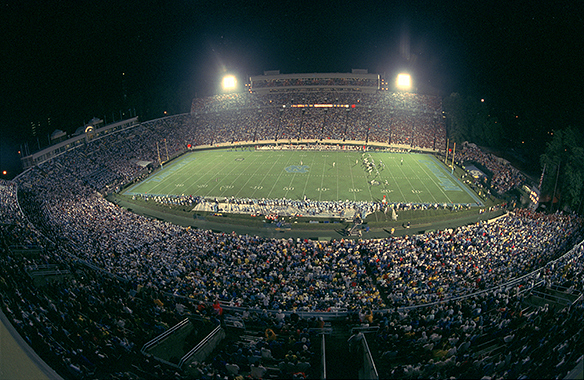
By the end of the first quarter, and trailing 10 to 0, the chances of that “repeat-history” seemed to be getting farther away. Carolina finally scored in the second quarter but trailed 24 to 7 at the half. That “repeat-history” was now . . . history. There was just too much Texas. Each team scored in the third quarter, but Texas poured it on with 21 points in the fourth. The final score was 52 to 21, Texas.
Following the win, Coach Brown hugged his players and looked toward those Texas fans as he held up the famous “Hook ‘em Horns” sign. The Texas band then played “The Eyes of Texas.” The Tar Heel hype for this game by now was forgotten. Texas was ranked #3 for a reason. They were that good.
Following the Mack Brown–John Bunting handshake at midfield, Coach Brown walked into the atrium of the old Kenan Field House at Kenan Stadium, a room in which he was totally familiar. He was set to address the media.
“I’ve never seen a team play that hard down 31 to 14. The crowd was in it, it was an unbelievable atmosphere. For myself, I’m really proud that North Carolina football is in John Bunting’s hands and moving forward.
“I was impressed with the crowd. I’m proud to be a part of the two biggest in school history. I’m just on the wrong side in one of them . . . . There was way too much talk about me coming back here. . . . We had our struggles and I’m proud of what we did here.”
Mack Brown’s position in Tar Heel history is secure with ACC Coach of the Year honors in 1996, three ten-win-seasons, and a number four national ranking (Coaches’ Poll) for the 11-1 1997 team.
Brown would go on to lead the Longhorns for eleven more seasons, winning the National Championship in 2005. You can see why he will be inducted into the College Football Hall of Fame in December.
Epilog
During his most recent campus visit, Coach Brown talked with the 2018 Tar Heel football team and told them it is a “privilege” to play in a historic and winsome venue like Kenen Memorial Stadium. He then added that he was pulling for them each Saturday from his ESPN studio vantage point where he is a network analyst each weekend during football season.
Category: Sports
Lath Morriss: the cheerleader they called Tarzan
With the 2018 football season kickoff tomorrow on the west coast against the University of California, Berkeley, many Tar Heel fans are ready for their annual rite of autumn. An important part of that rite is fan participation—cheering, it’s called. And no one in Carolina history cheered like the rotund man from Farmville, the unofficial UNC cheerleader they called Tarzan. He was not only famous on the UNC campus. Tarzan was a familiar face and voice at Duke as well as other schools across North Carolina. A View to Hugh awakens from its summer doldrums to the beat of Hugh Morton collection volunteer Jack Hilliard, who takes a look at the life and times of Lath Morriss.
Author’s Note: In researching this post, I found numerous spellings of the main character’s name—from Lathe to Lath, and from Morris to Morriss. In a Daily Tar Heel story published on December 12, 1946, the man himself says his name is Lath Morriss. So that’s what I will go with throughout this post.
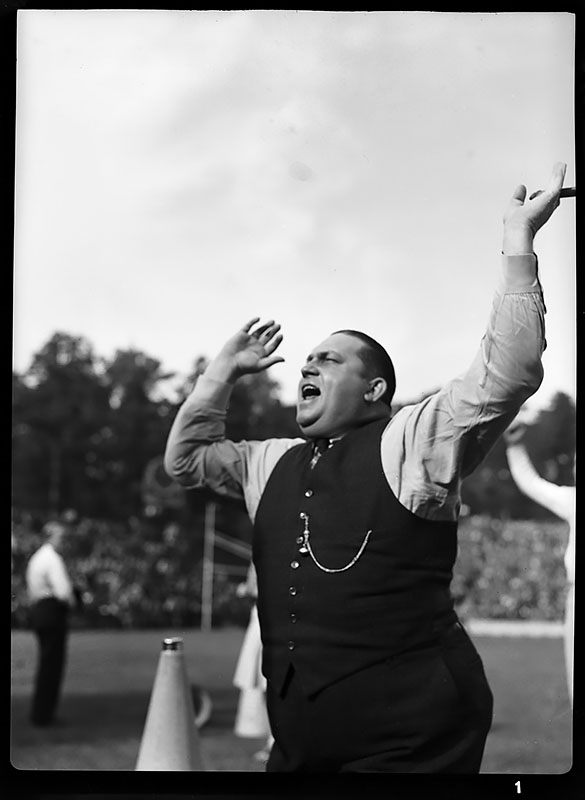
When Duke University’s Blue Devils traveled to Pasadena, California for the 25th annual Rose Bowl game on January 2, 1939, the opponent was the University of Southern California. Many Duke fans across North Carolina were not able to make the long trip to California for the game, so they listened to sportscaster Bill Stern’s coast-to-coast broadcast on NBC radio. Not only did they get Stern’s play-by-play account of the famous game, but another well known voice was heard during the broadcast. It was that of Lath Morriss cheering on the opposite side of the field from Stern’s broadcast booth.
Lath Morriss was born in Brenham, Texas on February 15, 1904 and spent his early years in and around that small town. He had a love for the game of football. He played fullback on his high school team and quarterback on his college team.

After college, Lath took a job in Port Arthur, Texas with the Smith Construction Company, which had recently acquired a contract to build a highway between Farmville and Wilson in North Carolina. When the construction company completed the road project, Morriss stayed in North Carolina and took a job in Farmville with the A.C. Monk Tobacco Company. He was often seen at football games at Duke and attended his first game in Kenan Stadium in 1927.
His unusual voice often became a distraction in the cheering sections. During a Duke – Colgate game in Duke Stadium, university security asked him to leave. The Associated Press, which covered the game, reported that Morriss had been evicted. Students who were seated near him that September day, however, said he just went across the field and started cheering for Colgate.
Morriss soon found a “home” in Chapel Hill on football Saturdays. He became known as the “Screaming Eagle” in The Daily Tar Heel but the students called him Tarzan. In a 1935 interview in The Daily Tar Heel, Lath said, “I reckon you might call a voice like mine somewhat unusual, but I believe it has its good points.”
UNC’s 1937 season opener against the University of South Carolina ended in a 13-to-13 draw. The Daily Tar Heel blamed Tarzan’s absence for the tie. S. R. Rolfe writing in the Sunday, September 26 issue said, “For the first time in memory . . . Tarzan was not at a Carolina ball game. That may be the reason for the tie. The team probably missed his ‘15 rahs’ and shrill yell.”
At the UNC pep rally on Fetzer Field for the 1946 Duke game, Tarzan was one of the featured speakers, along with another famous Carolina Cheerleader, Kay Kyser. A portion of the rally was broadcast on WPTF radio. Tarzan was in rare form the next day when Duke came into Kenan Stadium for the thirty-third meeting between the two old rivals. He led Rameses, the Carolina mascot, around the stadium to the delight of the photographers covering the game, as Carolina won 22 to 7 to cap off the first Duke–Carolina game of the “Golden Era” in Chapel Hill.
In a game billed as the “1947 Sugar Bowl Rematch,” the Tar Heels took on the Georgia Bulldogs in Chapel Hill on September 27. Following a 0-to-0 first half, Morriss led the Tar Heels back onto the field for the second half. With megaphone in hand; he shouted “Go, go, go, go . . . Care-lina.” The students shouted back, “Go, go, go, go . . . Tarzan.” Carolina came back in the second half to win 14 to 7 to the delight of the Tar Heel fans among the 43,000 in Kenan Memorial Stadium.
Tarzan’s picture was often displayed in The Daily Tar Heel, and in UNC’s yearbook, The Yackerty Yack (both the 1947 and 1949 editions). Even the magazine The State carried a cover photograph of the man from Farmville in its November 22, 1947 taken by photographer Bugs Barringer of Rocky Mount.
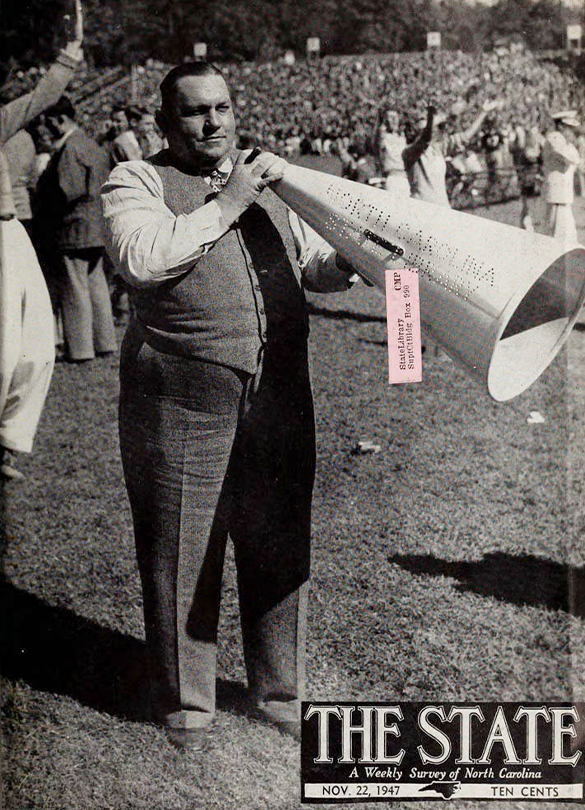
The year 1949 brought to a close the “Golden Era” of Tar Heel sports, but the Lath Morriss story continued in Chapel Hill. When The Chapel Hill Newspaper printed its sixth “Town & Gown” edition in August of 1975, it included a picture of Tarzan. And in 2016 when author and historian Lee Pace published his book Football in a Forest: The Life and Times of Kenan Memorial Stadium, he featured the following Hugh Morton image of Tarzan on pages 134-135.
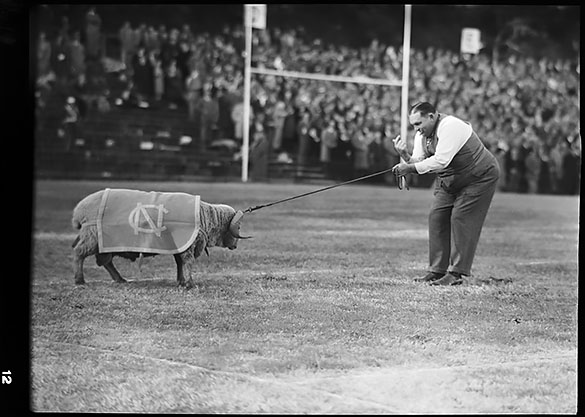
The sad news from Farmville on July 30, 1962 told of the passing of Lath Morriss. He was 58-years-old.
When Hope and Holshouser golfed at Grandfather
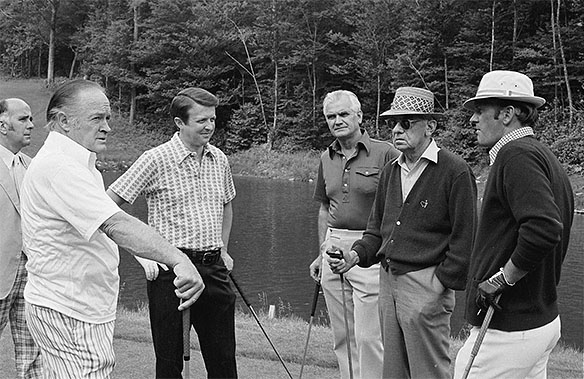
Earlier this month, Jack Hilliard wrote a post about the 1974 Singing on the Mountain and sent it to me for publication in time for this year’s Singing on Sunday, June 24. As I began proofing and fact checking the text and looking for images, some of the then-known details about a particular photograph weren’t falling in line, so I decide to do a bit of research to set the matter straight. What evolved is this parallel to Jack’s post. If you are arriving at this post first, it may be better to read his first (linked below).
As I discovered today, while preparing Jack Hilliard’s post about the 1974 Singing on the Mountain, that the above photograph by Hugh Morton was not made in June 1974 as was previously believed. Several newspapers published the photograph in their Sunday editions for June 23, 1974, the day of the Singing. One newspaper was the Greensboro Daily News as seen below. Notice the cropping compared to the full-frame negative above.

While researching Jack’s post, the logistics of Bob Hope traveling back and forth between Asheville and Linville wasn’t making much sense to me. So, I dug into newspapers.com to see if I could find any clues. Yep, another Morton Mystery arose: the same photograph published in The Times and Democrat of Orangeburg, South Carolina had a much more explanatory caption:
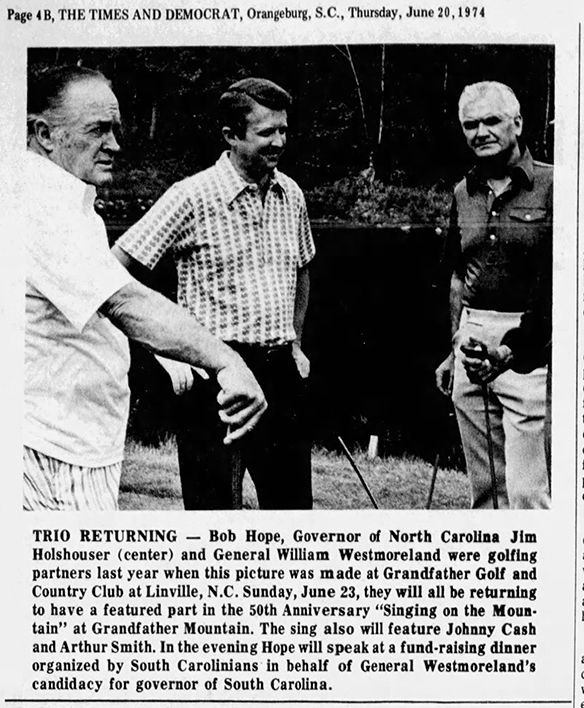
Turns out Morton made the photograph a year earlier! Back to newspapers.com to solve this mystery!
According to The Asheville Citizens staff writer Jay Hensley in his June 13, 1973 article titled “Governor Meets King of Quips,” Hugh Morton arranged a golf match to be played on the back nine holes at Grandfather Golf and Country Club on June 12, 1973. Morton paired North Carolina Governor James Holshouser and comedian Bob Hope to play against Clifford Roberts and Robert Kletcke—respectively, the president and golf pro of Augusta National Golf Course.
As cropped in the newspaper, one gets the impression that Hope, Westmoreland, Holshouser, and one other person identified only by a hand holding a golf club made up a foursome before, during, or after playing a round. (As we see from the full image, that hand belongs to Roberts.)
What was the purpose behind the outing? Hensley’s article does not say directly, but he does report the background around it. Holshouser and Hope apparently had played a round of golf on some previous occasion with Vice President Spiro T. Agnew. Hope and his wife Dolores were guests of General Westmoreland at the country club, there for a “short visit.” Westmoreland wanted to offer his guests complete relaxation during their stay, but Hope enjoyed the outing nonetheless. Hope’s wife Dolores, Hugh Morton’s sister Agnes, and Raleigh attorney Camelia Trot played in a group after the men.
Again according to Hensley, Holshouser “broke off from a Tuesday meeting of the Southern Regional Education Board” being held in Hot Springs, Virginia. Linville is a four-and-a-half-hour drive from Hot Springs, so it was quite a break off unless traveling by air.
Westmoreland was nursing an injured right arm, so he didn’t even play. Instead, he “restricted his activities to putting around the golf course.” A caption in a photograph published in the June 15 edition of the newspaper described the group, however, as a fivesome.
Here are two quips Hope offered during the round:
- “Smile and they’ll think we are winning,” he said to Holshouser.
- “I thought this course was named for me until I met you,” he told Clifford Roberts. Roberts was 79 year old at the time, Hope 70.
The 1983 “Mello Yello 300”
A couple of recent media reports indicate that stock car racing as we have known it since the late 1940s might be undergoing some changes. It has been reported that NASCAR’s founding-family, the France family, is looking for a buyer. On a different track, a couple of weeks back on May 12th, NASCAR’s “King” Richard Petty sold, in his words, “a bunch of stuff,” (more than 170 items) from his memorabilia collection, including his iconic No. 43 Day-Glo red and Petty Blue 1974 Dodge Charger, considered one of the most historically important cars in NASCAR history. It sold for $490,000 So with changes looming overhead, NASCAR heads into its big 2018 twin bill weekend in Charlotte with the Alsco 300 on Saturday and the Coca-Cola 600 on Sunday.
Back on October 10, 2014, A View to Hugh featured the 1971 “National 500” at the Charlotte Motor Speedway. We noted that, while High Morton is famous for his sports photography, there aren’t many NASCAR events represented in his portfolio.
Then about this time last May, Jack Hilliard wrote a post about the 1983 “World 600” at CMS. While writing the post he thought there were images from that race in the Morton collection, but after careful study, I determined that the suspected “World 600” images were actually from a “600” preliminary race: the 1983 “Mello Yello 300.” Our post, titled “Back at the Track,” turned out to be a “Morton Mystery” solver. Thirty-five years ago, on May 28, 1983, Morton actually was present to photograph a Late-Model-Sportsman race at the famous speedway. Morton collection volunteer Jack Hilliard takes a look back at that rare occasion when Morton documented the 1983 “Mello Yello 300.”

On Friday, May 27, 1983, Late Model Sportsman driver Morgan Shepherd (Car #7) from Conover, North Carolina literally dodged the rain drops to win the pole position for the 300 mile race to be run the following day. Shepherd’s speed of 161.565 miles-per-hour beat Neil Bonnett (Car #75), who would start on the outside front row with a speed of 160.598. Rounding out the top five qualifiers were Dale Earnhardt (Car #15), Harry Gant (Car #28), and Bill Elliott (Car #17). Twenty additional positions had been filled the day before on Thursday, May 26th.
The rain drops were gone on Saturday, May 28th as 75,000 race fans came out for the “Mello Yello 300.” Dale Earnhardt (Car #15), from nearby Kannapolis, took the lead from Neil Bonnett (Car #75) on the second lap. Earnhardt held the lead for fifteen laps. Then, Bonnett, Earnhardt, and Harry Gant (Car #28) took turns sharing the lead until lap 50, when Earnhardt made an unscheduled pit stop under green. His stop cost him a lap. He would say after the race, “I thought we had a tire going bad.” But the problem was actually a handling issue which the Earnhardt team battled most of the afternoon.
Pole sitter Morgan Shepherd (Car #7) exited the race on lap 53, suffering a broken shock mount on the rear end of his Oldsmobile. With Earnhardt a lap down, it was Bonnett and Gant playing leap frog with the lead. Then On lap 76, a crash took out the current Late Model points leader, Asheboro’s Sam Ard (Car #00). Three laps later, on lap 79, Earnhardt got his lap back.
On lap 93, Bill Elliott (Car #17) took over the lead for 26 laps before Gant got back in front on lap 119. But by lap 100, Earnhardt had gotten back into second place and then on lap 136 he took over the lead for good leading the final 64 laps to take the win, beating Neil Bonnett by about 5 seconds. The winning speed for Earnhardt’s yellow and blue Wrangler Pontiac was 117.724 miles per hour. For his win, he got $9,100 and overall he led 83 of the 200 laps run.
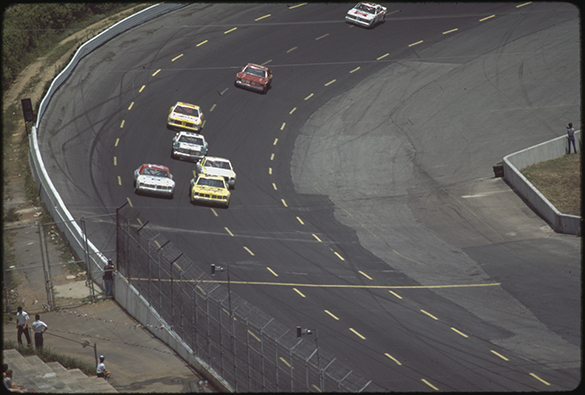
Earnhardt battled Bonnett a good part of the afternoon, which Morton captured from his position high above the track. Bonnett, who led the race 7 times for 61 laps, said “I felt pretty good out there until the last restart when we felt a valve spring breaking.” For Earnhardt, this particular victory was a breakthrough since he had never before won this race, having twice finished second. Neil Bonnett would go on to win the 1983 “World 600” the next day with Earnhardt finishing 5th.
Addendum by Stephen Fletcher
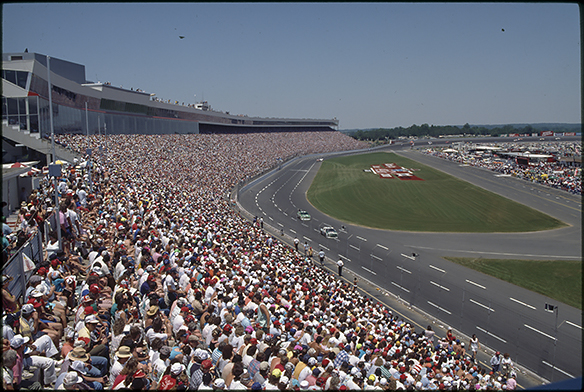
Want to help solve a “Morton Mystery?” The slide above is different from the rest of the slides in lot PTCM2_8894. The first eleven slides in the set are in Kodak cardboard mounts numbered between 9 and 21; the slide above, however, is in a Pakon plastic mount with dot-matrix printing that reads, “D.H. 600-39” and [slide number] “29.” The large infield logo seen above (detail below) is not in the infield seen in the opening image of last year’s post. Can anyone identify the race in the above image? Is it a different year of the 600? Is “D.H.” the initials of another photographer? (There are several images in the Morton collection by other photographers.) Please let us know what you think!
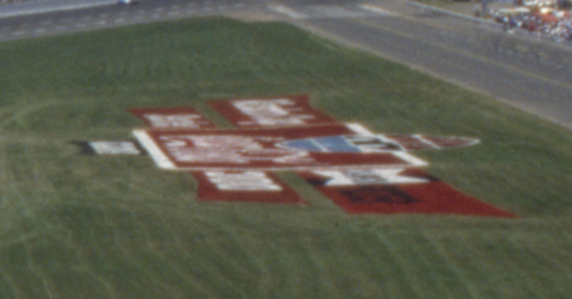

UNC's first NCAA Division I Tournament in Charlotte
On March 18th, 2012 Bill Richards, a colleague who worked in the library’s Digital Production Center, passed away unexpectedly while watching the Tar Heel’s basketball team defeat Creighton University in the “Sweet Sixteen” round of the NCAA Men’s Basketball Tournament. In 1982, Bill was the Chief Photographer for the Chapel Hill Newspaper. In 1988, he began working as a photographer and graphic designer in the UNC Office of Sports information. In 1998 he started working in Library Photographic Services, but continued shooting for Sports Information into the 2000s. I am dedicating this blog post, as I have each year since his departure, to Bill who, like Hugh Morton, was an avid UNC basketball fan.

In 1975, the UNC men’s basketball team found itself in the NCAA Tournament once again—not because it was yet another year in a long string of consecutive appearances, but because the team did not make the big dance the previous two years. Charlotte hosted the East Regional games in 1973, which was the final year of the NCAA University Division Basketball Tournament; UNC, however, was MIA because they played in the NIT in NYC. There they finished in third place, making it to the semifinals but losing to Notre Dame 78–71, but defeating the other semifinal loser, Alabama, 88–69. The next year, 1974, also found the Tar Heels playing in the NIT, but they were one-and-done with an eleven-point loss to Purdue, 82–71 in their first contest.
UNC entered the 1975 NCAA Division I Basketball Tournament after capturing the ACC Tournament as the second seed with three narrow victories. They defeated, in order, seventh seed Wake Forest in overtime, 101–100; third seed Clemson in overtime, 76-71; and fourth seed North Carolina State, 70–66.
The 1975 NCAA Tournament was the first to field thirty-two teams without first round byes, and the second that officially determined the Division I champion. Two cities hosted the first round games for the East region: Charlotte and Philadelphia. UNC played its first round opponent, New Mexico State, at the Charlotte Coliseum on March 15. New Mexico State had finished second in the Missouri Valley Conference behind Louisville. Also playing in Charlotte that day was Furman University against Boston College. The winners of both these games would head to Providence, Rhode Island for the Eastern Regionals.
With the game just down the road, Hugh Morton was court-side in the coliseum with his camera, capturing Phil Ford, Mitch Kupchak, Mickey Bell, and Walter Davis on black-and-white film. Eleven negatives survive, five of which can be seen on the online collection of Morton’s photographs. The Tar Heels easily handled the Aggies, 93–69. Boston College was also victorious, defeating Furman, 82–76. Both victors headed off to the Ocean State for their Thursday Eastern Regional semifinals: UNC versus Syracuse and Boston College against Kansas State.
UNC and Syracuse hadn’t played against each other since the Tar Heel’s perfect 32–0 season in 1957. The twentieth ranked Orangemen from Syracuse upset the sixth ranked Tar Heels in a close game, 78–76. Boston College fell at the hands of Kansas State 74–65. Back then, the regional losers played a third-place game, so both teams hung around until Saturday, when UNC whipped BC 110–90.
Morton did not make the journey to Providence, so the only 1975 NCAA Tournament photographs in the collection are those from the first round game played in Charlotte.
Correction 20 March 2018: The post initially stated UNC defeated number-one seed Maryland, 87–85 in the second round of the 1975 ACC Tournament. UNC defeated Clemson, 76–71, not Maryland. North Carolina State defeated Maryland, 87–85.
A drive to Washington DC with Barrier: part 3
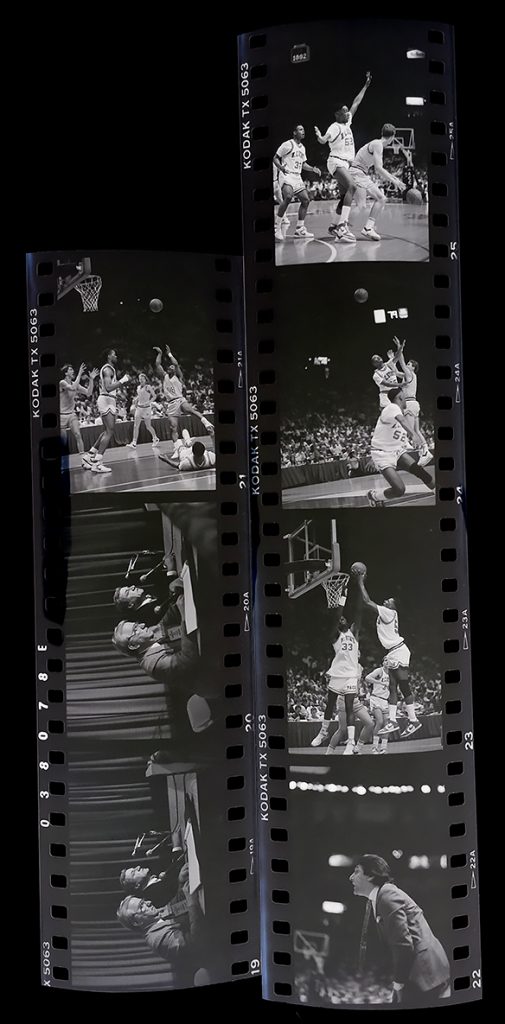
This is the third and final entry summarizing Hugh Morton’s drive to Washington D.C. with Smith Barrier to photograph the Jesse Helms, the ACC Tournament, and David Brinkley. The series was to be four parts long, but the collection materials just didn’t rise to the occasion. What happened?
Saturday, March 7: “ACC”

Morton, as you might expect, photographed the semifinals played between UNC and Virginia, and NC State and Wake Forest. As noted in the previous post in the series, the images from this ACC tournament are a bit scattered in the collection. Negatives and slides from March 7 are very scarce and can be found here in the collection:
- Roll Film Box P081/35BW-17 (35mm black-and-white negatives)
- Envelope 6.1.1-5-304: includes UNC vs. Virginia (5 negatives), but only four shots on the sidelines of a young person next to a water cooler, and a shot of the scoreboard showing a 72–72 tie with 0:22 on the clock, plus two frames during Dean Smiths’s press conference. There are no game action black-and-white negatives.
- Slide Lot 009598 (35mm color slides)
- UNC vs. Virginia (31 slides): Morton’s slides from this game are uncharacteristically under exposed.
Penciled into his calendar was a dinner with “Babb, Cookerly, Thigpen, Sachs” suggesting that the dinner gathering was planned after the initial entry of ACC in ink. I searched the collection finding aid and online images and found nothing. Does anyone know who these people were? With some more details we might be able to figure out if images exist under a topical description.

Sunday, March 8: “ACC”
Sunday morning at 9:30, Hugh Morton photographed fellow Wilmington native David Brinkley on the set of ABC News Washington. Photographically speaking it was the highlight of his day. That afternoon, UNC lost to NC State 68–67, and Morton’s 35mm slides were once again mostly underexposed. The day’s end? “Drive Gbo.” Unlike today’s digital days when you can instantaneously review your exposures on the back of your camera, Morton would’t know until after he sent off his film to be chemically processed in a lab and reviewed the results on his light table that he had underexposed his ACC tournament color slides.
UNC doesn’t always win basketball tournaments, and even Hugh Morton had a bad couple days court-side. Fortunately for us today, his trip to DC produced excellent results with several photographs of two of North Carolina’s most notable people of their time.
A drive to Washington DC with Barrier: part 2
Today’s post is part two of a four-day, four-post series covering a trip Hugh Morton made to the Washington D.C. area between Wednesday, March 4 and Sunday, March 8, 1987. Part one of this series covered March 5th, when Morton photographed United States Senator Jesse Helms. Today’s post covers the March 6th, the first day of the 1987 Atlantic Coast Conference Tournament.
Friday, March 6: “ACC Landover”
As is the case today in 2018, March 6th was the first day of the 1987 ACC Tournament, played in Andover, Maryland at Capital Centre. Morton photographed the following game between Virginia and Georgia Tech . . .
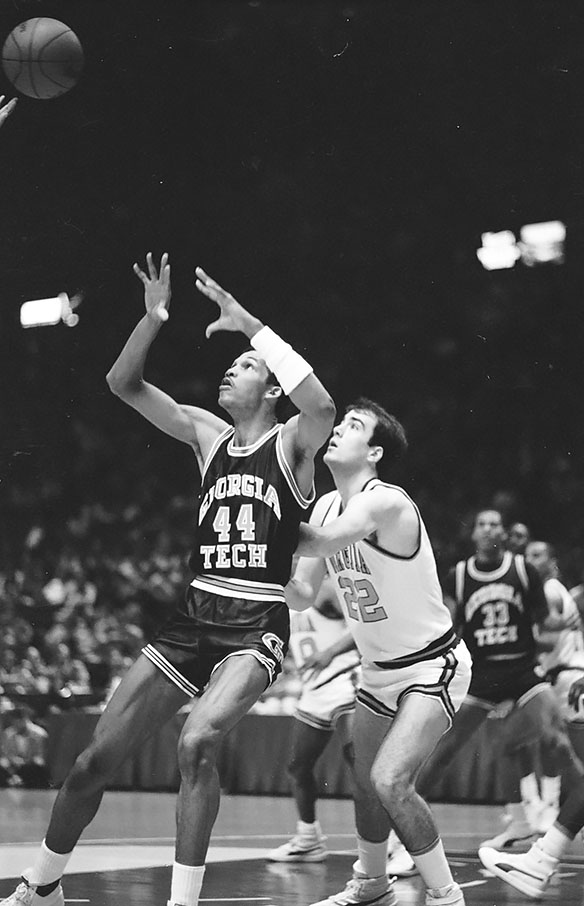
and UNC’s matchup with the local favorite, Maryland.
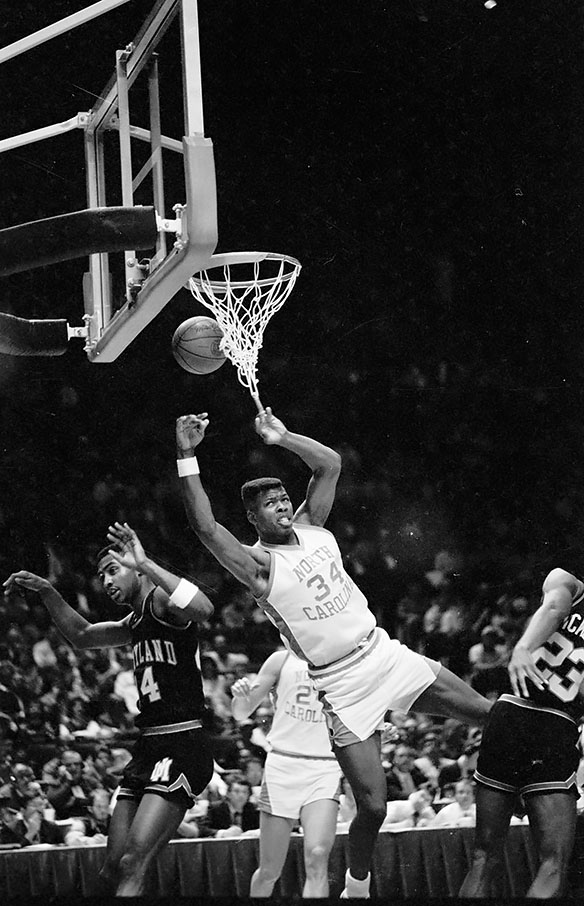
Most of Morton’s work from this opening quarterfinal round has not been digitized. The negatives and slides in the collection for the various games of the tournament are a bit jumbled. Below is a list of black-and-white negatives and color slides for games played on March 6, excerpted from the Morton collection finding aid:
- Roll Film Box P081/35BW-17 (35mm black-and-white negatives)
- Envelope 6.1.1-5-302: Georgia Tech vs. University of Virginia (3 negatives)
- Envelope 6.1.1-5-303: UNC vs. Maryland (6 negatives)
- Envelope 6.1.1-5-304: includes UNC vs. Maryland (11 negatives). This envelope includes loose strips from all three days of the tournament.
- Slide Lot 009600 (35mm color slides)
- UNC vs. Maryland (3 slides)
- Virginia vs. Georgia Tech (2 slides)
- Clemson vs. Wake Forest (7 slides)
- Duke vs. North Carolina State (5 slides of game action, 4 slides of post-game press conference—3 of NC State coach Jim Valvano and 1 with Duke coach Mike Krzyzewski).
Sorting out the above was very confusing! Since I took the time to figure out what was what, I decided to record it here for anyone’s future reference. There were some errors in the finding aid, too, so I submitted corrections for those.
Four ACC Tournament firsts from 1967
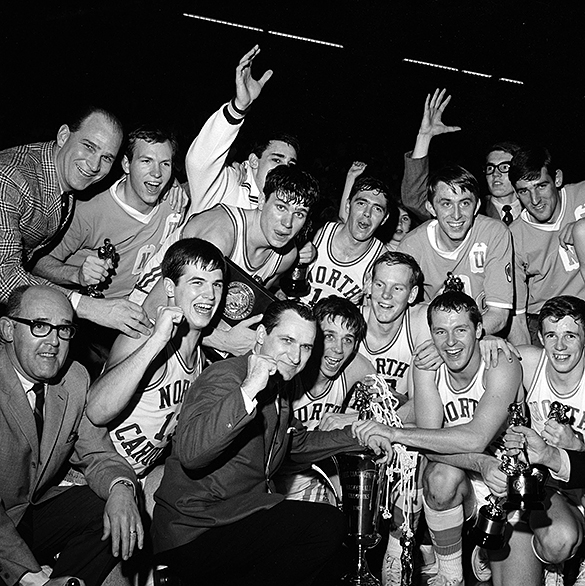
The 65th annual Atlantic Coast Conference men’s basketball tournament will be staged in Brooklyn, New York beginning today, March 6th, 2018. The tournament will return to North Carolina next year when the event will play out in Charlotte. In 2020 the tournament will return to Greensboro for the 28th time, a series that began in 1967.
Morton collection volunteer/contributor Jack Hilliard takes a look back at the ’67 UNC season and an ACC Tournament which was one for the record books.
Carolina’s 1966-67 basketball season got off to a routine start, but finished in a flurry of firsts. An eleven-point win in Chapel Hill against Clemson for the nineteenth straight time tipped off the season, but was hardly anything to write home about. Next was a trip to the Greensboro Coliseum for a thirty-point victory against Penn State, followed by seven straight wins—including a win at Kentucky and two more visits to the Greensboro Coliseum with wins over NYU and Furman. As the season played out, the Tar Heels lost only four regular season games, and they headed into the 1967 ACC Tournament as the regular season conference champion with an ACC record of 12–2.
For the first time since its beginning in 1954, the ACC played its conference tournament away from Reynolds Coliseum in Raleigh. In 1966 the conference established a rotation arrangement for tournament hosts, electing to play the 1967 tournament at the Greensboro Coliseum—much to delight of UNC Head Basketball Coach Dean Smith. Smith had favored a neutral site for the tournament and he thought Greensboro was a good fit, even though the coliseum, at that time, had 3,600 fewer seats than Reynolds Coliseum.
Coach Smith and his North Carolina Tar Heels came into the tournament as the number one seed. This was only the second time UNC had been seeded as tournament number one, the first time being the year of “McGuire’s Miracle” after the 1956-57 regular season.
Photographer Hugh Morton made the trip up from his home in Wilmington to document this first Greensboro ACC tournament. (Morton was a fixture courtside at the ACC Tournaments and much of his work can be found in the 1981 book The ACC Tournament Classic by Hugh Morton and Smith Barrier.) Currently there are sixteen photographs made by Morton during the tournament available for viewing in the online collection. The Morton collection finding aid indicates that thirty-four black-and-white and eight color photographs from UNC’s games versus North Carolina State, Wake Forest, and Duke.
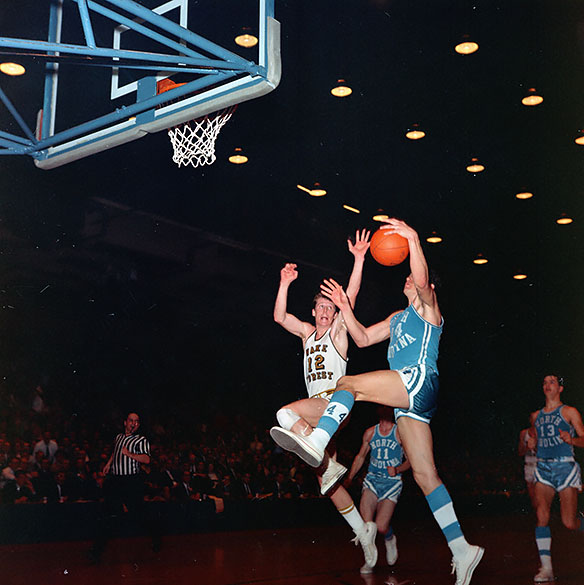
Three days before the tournament, Greensboro Daily News sports editor Smith Barrier predicted Duke would take the tournament despite the fact that Carolina had beaten Duke twice during the regular season.
The 1967 ACC Tournament, the 14th annual event, tipped off at 1:30 PM on Thursday, March 9th with 8,766 fans watching South Carolina beat Maryland 57–54. Duke defeated Virginia 99–78 in the second afternoon game.
The first round evening game pitted North Carolina against North Carolina State—a game that turned out to be much closer than most expected. Since Carolina was 12—2 in the ACC and State was 2–12, most folks thought the Tar Heels would have no trouble. Head coach Norman Sloan and his Wolfpack had a different idea. At the half the score was tied at 26. Carolina was able to hang on and win 56–53. The second evening contest saw Wake Forest defeat Clemson 63–61 in double overtime.
On Friday, March 10th, the first semifinal game had Smith’s Tar Heels playing Jack McCloskey’s Wake Forest Demon Deacons. Wake led by four at half, 38–34, but thanks to Larry Miller’s 29-point-second-half, the Tar Heels came away with 89–79 victory. The second Friday game had coach Vic Bubas’ Duke Blue Devils beating coach Frank McGuire’s South Carolina Gamecocks 69–66 and set up a Duke–Carolina final.
UNC All American Larry Miller had cut out Smith Barrier’s newspaper column predicting a Duke championship, and on championship game day he put the clipping in his shoe.
At 8:30 PM on Saturday, March 11, 1967 it was the “Battle of the Blues.” Carolina, for the first time in the tournament, played like most Tar Heel fans thought the number one seed should play and led 40–34 at half. Thanks to Larry Miller’s 32 points, the Tar Heels held on to win 82–73, but the game was really closer than the nine point difference. Coach Smith got a ride on the shoulders of his winning players and called the Duke win “the greatest victory I’ve had as a coach.”
Miller took home the Outstanding Player award. Following the post game press conference, he presented the clipping to Smith Barrier. According to author Art Chansky in his 2016 book Game Changers, Barrier “took it in good spirit.” Sandy Treadwell, Managing Editor of The Daily Tar Heel wrote in the March 12th issue, “The Tar Heels ended a long road of twenty-eight basketball games. It was a road that took them into national prominence, and which last night earned them a ticket to the NCAA Eastern Regional Tournament in Maryland later this week.”
When the 14th annual Atlantic Coast Conference ended, a total of 35,064 fans had witnessed a tournament for the record books. Historians of the game went to work and discovered it was the first time that:
- the conference played the tournament outside Reynolds Coliseum in Raleigh. (The tournament hasn’t been played in Raleigh since 1966, but there is currently talk of playing the tournament, or part of the 75th anniversary tournament in Raleigh in 2028.)
- the conference played the tournament in the Greensboro Coliseum. (Since then, Greensboro has hosted the tournament twenty-seven times.)
- UNC’s Dean Smith won the ACC Tournament Championship. (Smith’s teams went on to win a total of thirteen ACC Tournaments before his retirement following the 1997 season.)
- UNC had beaten the three other members of the “Big Four” (Duke, N.C. State, and Wake Forest) during an ACC Tournament—a fete that hasn’t happened since.
A drive to Washington D.C. with Barrier: part 1
It’s often useful when researching Hugh Morton images to check his executive planners. I’ve used examples of this practice before, and for today’s post this tactic provided some insight into one particular journey in March 1987.
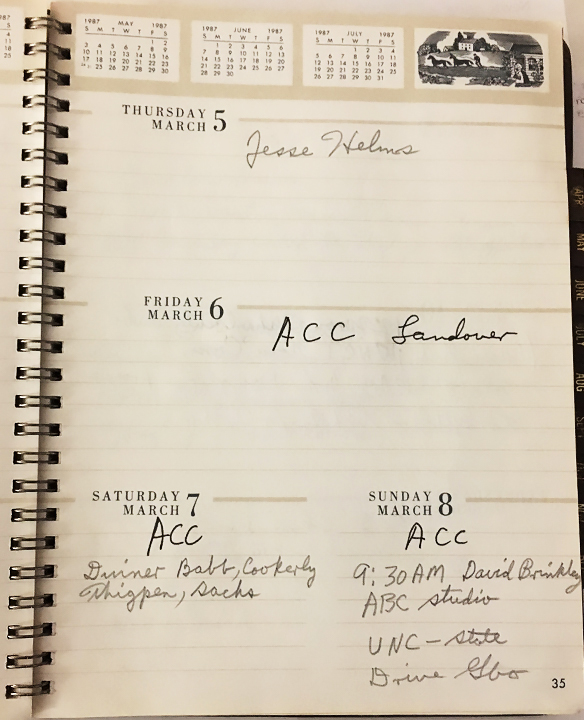
Wednesday, March 4: Drive Wash DC with Barrier
One of Morton’s two entries for March 4th reads, “Drive Wash DC with Barrier.” Henri Smith Barrier Jr. was a member of the UNC class of 1937—just six years ahead of Hugh Morton’s class of 1943—but he received his Bachelor of Arts degree in journalism in 1940 when Morton was a UNC student. Barrier was sports editor of the Concord Tribune, his hometown newspaper, for two years before he joined the Greensboro Daily News in 1941. Just six years before this road trip, in 1981, Barrier wrote and edited the book The ACC Basketball Tournament Classic that featured Morton’s photography. Barrier passed away a little more than two years after this DC journey on 2 June 1989.
Thursday, March 5: “Jesse Helms”
That’s Morton’s plain and simple entry, but why did Morton schedule a photography session with Jesse Helms? I suspect it was a self-assignment for his collaborative book with Ed Rankin titled Making a Difference in North Carolina. Rankin and Helms were roommates in 1941 when they were newsmen at The News and Observer and The Raleigh Times, respectively. In 1987 Helms was serving his third term as North Carolina’s senior United States Senator. The state’s junior senator was Terry Sanford, elected just a few months earlier in November 1986.
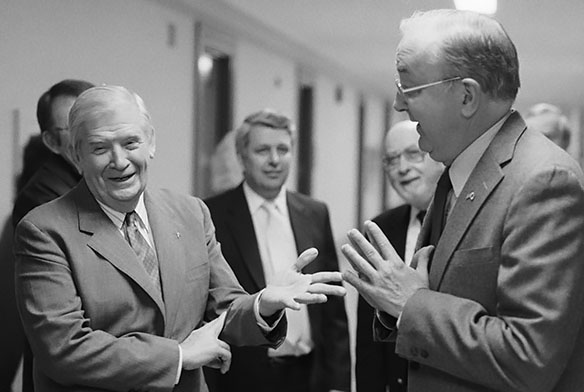
The Morton collection finding aid states there are seventy-six black-and-white 35mm negatives in Subseries 2.1, which is devoted to the negatives Morton pulled together during the making of Making a Difference in North Carolina. There are thirteen 35mm color slides from this same date in Subseries 2.6: “People, Identified.” Currently there are twelve of these images related to Morton’s coverage Helms available in the online collection.
A caption in Making a Difference in North Carolina notes that one event Morton photographed that day was a confirmation hearing for Jack F. Matlock Jr. held by the United States Senate Committee on Foreign Relations. Matlock was a native of Greensboro and a Duke University alumnus. From the extant negatives and slides, it appears Morton did not photograph Matlock. On another note of interest, Senate Foreign Relations Committee member Senator Edward Zorinsky, Democrat from Nebraska, died the next day, March 6th, at the 1987 Omaha Press Club Ball. In the photograph below, is that Senator Zorinsky on the right? It may be hard to tell for certain because there is not a full resolution scan online to zoom in and look more closely, so below is a cropped detail.
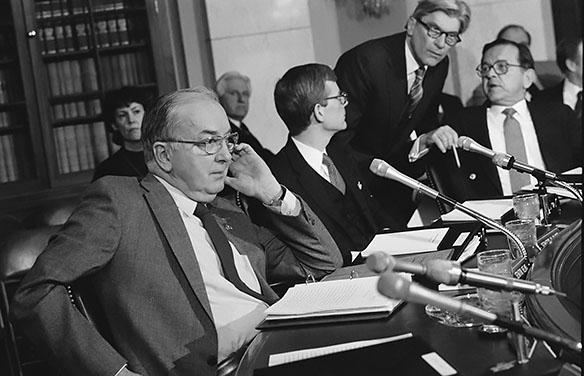
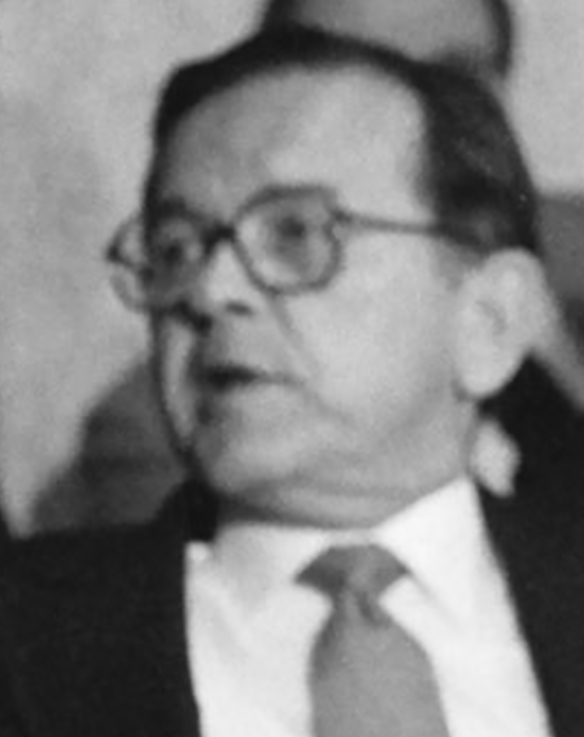
Another similar photograph for a different angle . . .
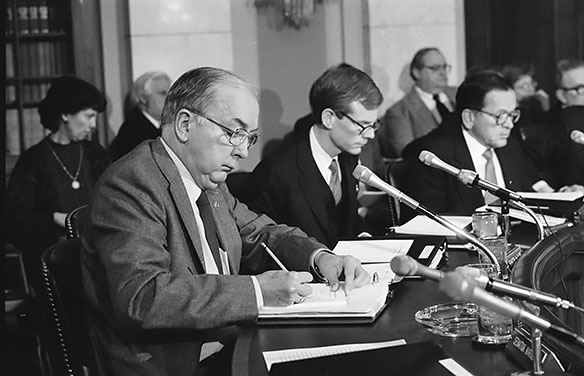
One photograph from the day serves as an excellent example of why photographic archives desire to obtain negative collections, not just photographic prints. Below is a photograph of Helms with Senator John Warner of Virginia as published in Making a Deference in North Carolina . . .
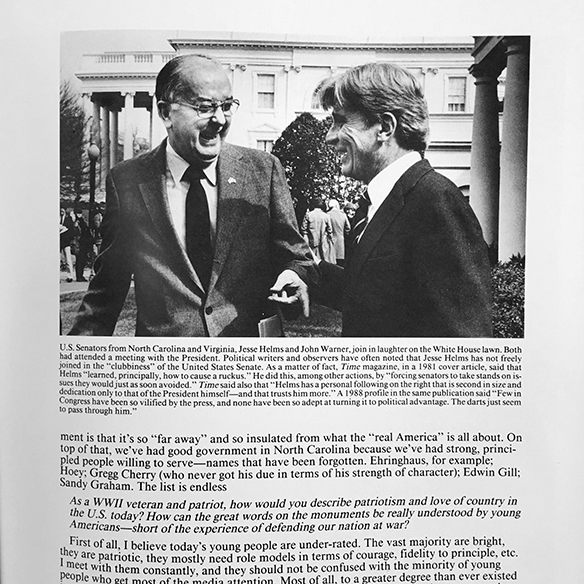
. . . and here’s a scan of the entire negative . . .
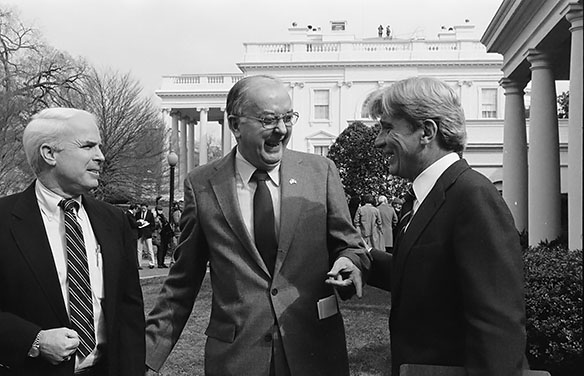
For the book, Morton decided to crop out Arizona’s senator John McCain.
Here’s another photograph from the day that’s not in the online collection:
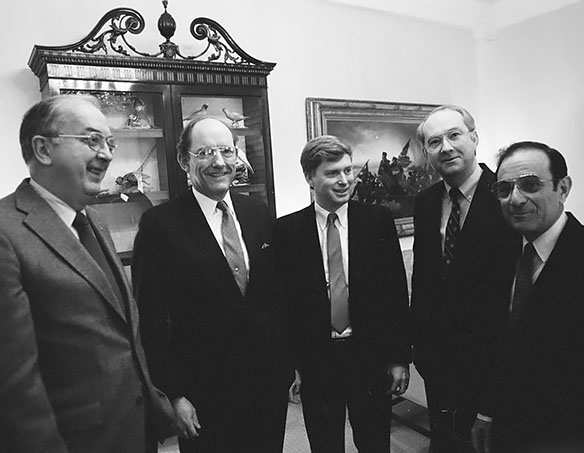
I recognize Helms (left) and Dan Quayle (center). Want to try your hand on the others?
Tune in tomorrow for part two: Friday, March 6: “ACC Landover.”
ADDITION made on 8 March 2018: negatives depicting West Virginia Senator Robert Byrd appears in some of the negatives made on this day, but I did not use one for this blog post. I noticed afterward, however, that there is a separate listing for three 35mm negatives in the Morton collection finding aid for Robert C. Byrd made on March 5, 1987 (the date in the finding aid is March 6th) in Envelope 2.1.48-5-1.
58 and 0: a Clemson streak of frustration
The UNC Tar Heels will host the Clemson Tigers on Tuesday, January 16th, 2018 in the Dean E. Smith Center on the Carolina campus. The game will mark the 59th meeting between the two teams when playing in Chapel Hill. Carolina has won all 58 of the previous Chapel Hill games, an NCAA record for the longest winning streak against a single opponent. Morton Collection volunteer Jack Hilliard offers a look back at the Clemson streak of frustration.
Prolog
The Clemson frustration in never having won in Chapel Hill was summed up by Clemson Head Coach Rick Barnes following his loss in 1997. When asked in the Clemson locker room after the game by a reporter, who obviously didn’t know Coach Barnes very well: How do you explain your program’s head-shaking losing streak in Chapel Hill? Said Barnes, “If you really need an explanation, take you’re a– out there and look up at the rafters.”
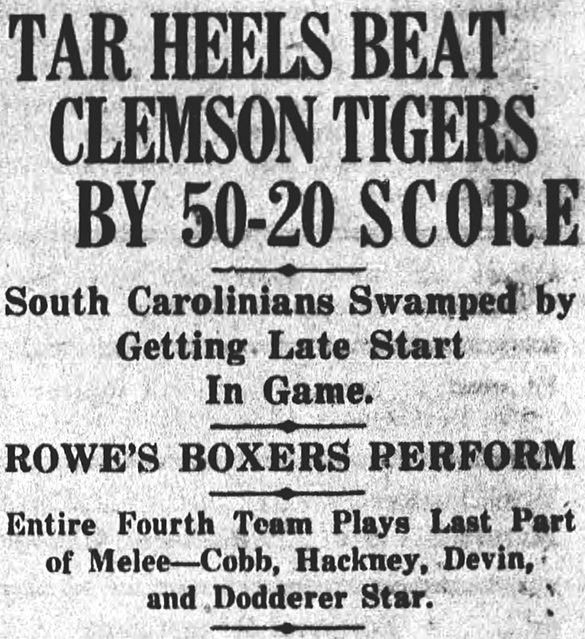
It all started on Friday, January 15th, 1926, in a metal-constructed arena on the UNC campus called the Indoor Athletic Court (It would become known as the “Tin Can.”) UNC’s “White Phantoms” (as the basketball team was often called in those days) beat Clemson College by thirty points, 50-20. The student newspaper, “The Daily Tar Heel” called the point spread a “massacre.”
While the Carolina band blared the note of “Hark the Sound” and “Here Comes Carolina,” the Tar Heel tossers took the court and limbered up for the massacre.

Seven seasons would pass before the two teams met in Chapel Hill again, in 1934. This time Carolina won by twelve, with a final score of 38-26 as 2,500 fans packed the “Tin Can” to open the 1933-34 season.
The game on January 3rd, 1936 was the closest game to date in the Chapel Hill series. Carolina won 24-23 in the final game played in the “Tin Can.”
When the two teams met in Chapel Hill for the fourth meeting in the series on February 1st, 1938, Carolina was hosting in Woollen Gym with a 44-34 win. UNC would host and win the three games of the 1940s by double digits, winning the 1943 game by twenty, 52-32.
Clemson played twice at Chapel Hill during Morton’s years as a UNC student photographer. Only once—UNC’s 47-30 win on February 19, 1940—when he would have been able to photograph the game. Neither the student newspaper, The Daily Tar Heel, nor the nor the yearbook, The Yackety Yak, published a photograph from the game. The second Clemson visit to Woollen Gym was on February 2, 1943, but Morton enlisted in the United States Army during the autumn of 1942 and only came back to campus to photograph for the yearbook on one occasion in October 1942.
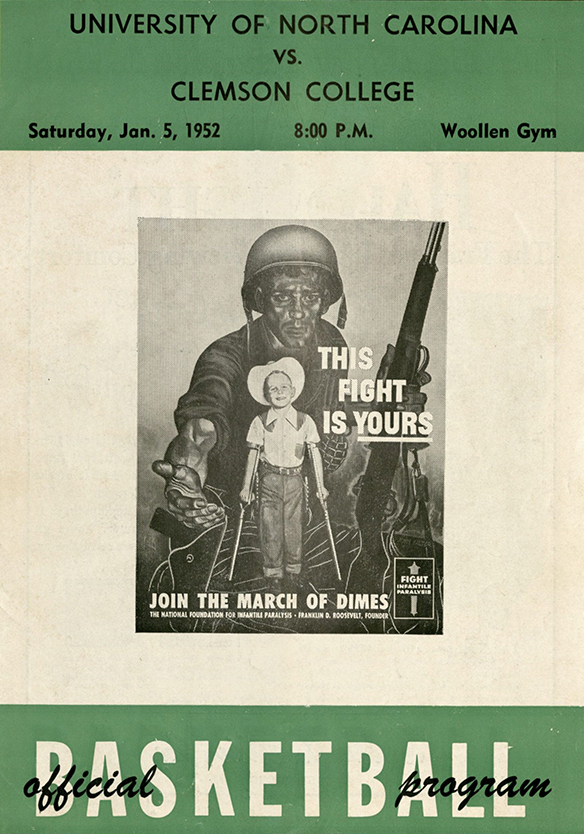
Clemson traveled to Chapel Hill twice in 1952. Saturday, January 5th, 1952 marked the eighth meeting between the two with another UNC win 65 to 59. The following season, on December 10th, 1952 the series played out in Woollen Gym with a Tar Heel win, 82-55. It would be UNC head coach Tom Scott’s only Carolina–Clemson game in Chapel Hill.
When Clemson came into Chapel Hill on December 19th, 1953, the two teams were now members of the newly formed Atlantic Coast Conference and Carolina’s new head coach Frank McGuire led his Tar Heels to a thirty-seven-point-victory, 85-48—the largest point difference in the series to date.
A thirty-three-point win in 1954 and a fifteen-point win in ’55 set the table for the famous 1956-57 championship season, which included a McGuire led Tar Heel win 86-54 on January 11th, 1957.
When Clemson came into Woollen Gym for the fourteenth meeting, on December 7th, 1957, something had been added. Television producer C.D. Chesley had brought in his TV cameras for the first regular season ACC game ever and Carolina came away with a 79-55 win.
Coach McGuire and his Tar Heels met Clemson one more time in Chapel Hill during his time as coach, an 83-67 win on December 3rd, 1958.
On January 3rd, 1961, new Head Coach Dean Smith led Carolina to a 77-46 win—the first of twenty-eight Chapel Hill wins over Clemson during his Tar Heel tenure. The Heels won by sixteen in 1962, and when Clemson came into Chapel Hill on December 1st, 1964 for the eighteenth meeting, they were no longer called Clemson College but were called Clemson University—but continued the losing streak, 77-59.
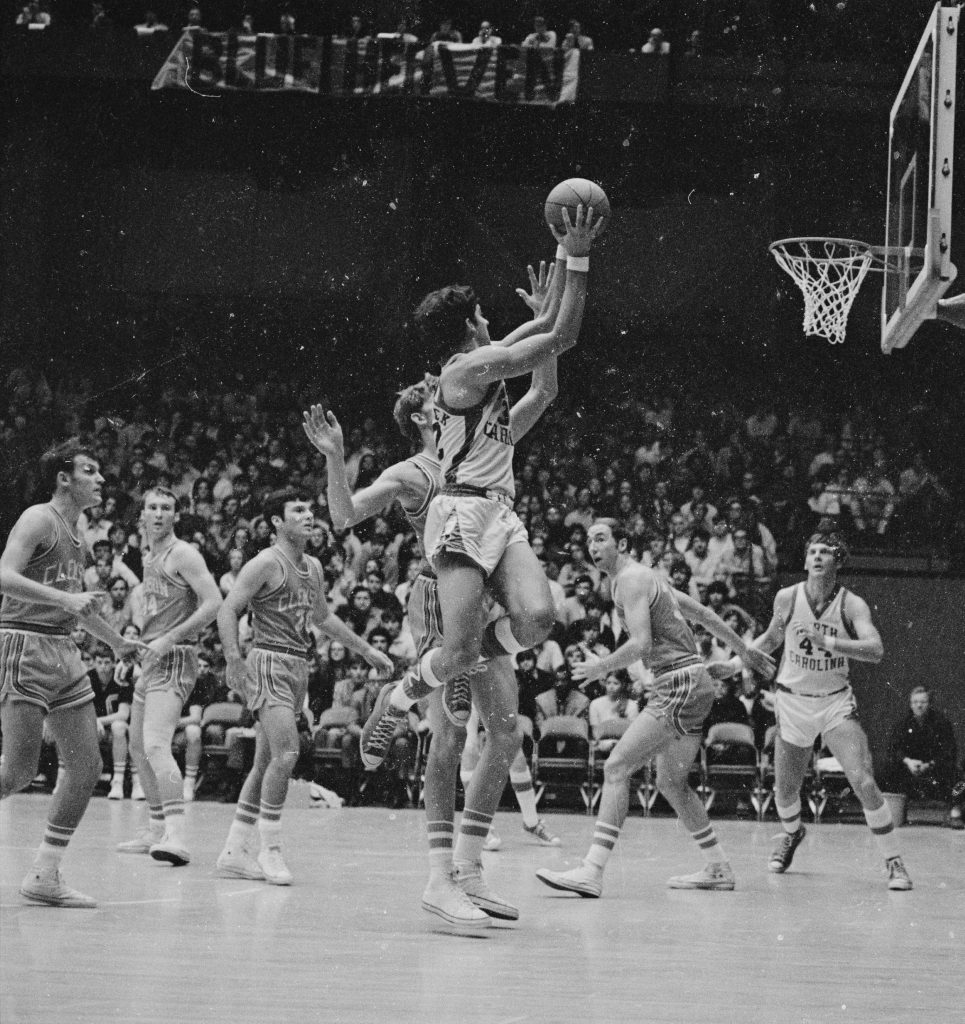
Coach Smith led his Tar Heels to double digit wins, in 1966, 1968 and 1971. Photographer Hugh Morton was in place in Carmichael Auditorium (now called Carmichael Arena), for Carolina’s 1971 win, 92-72. Surprisingly, it was Morton’s first coverage of a UNC–Clemson contest on a UNC basketball court.
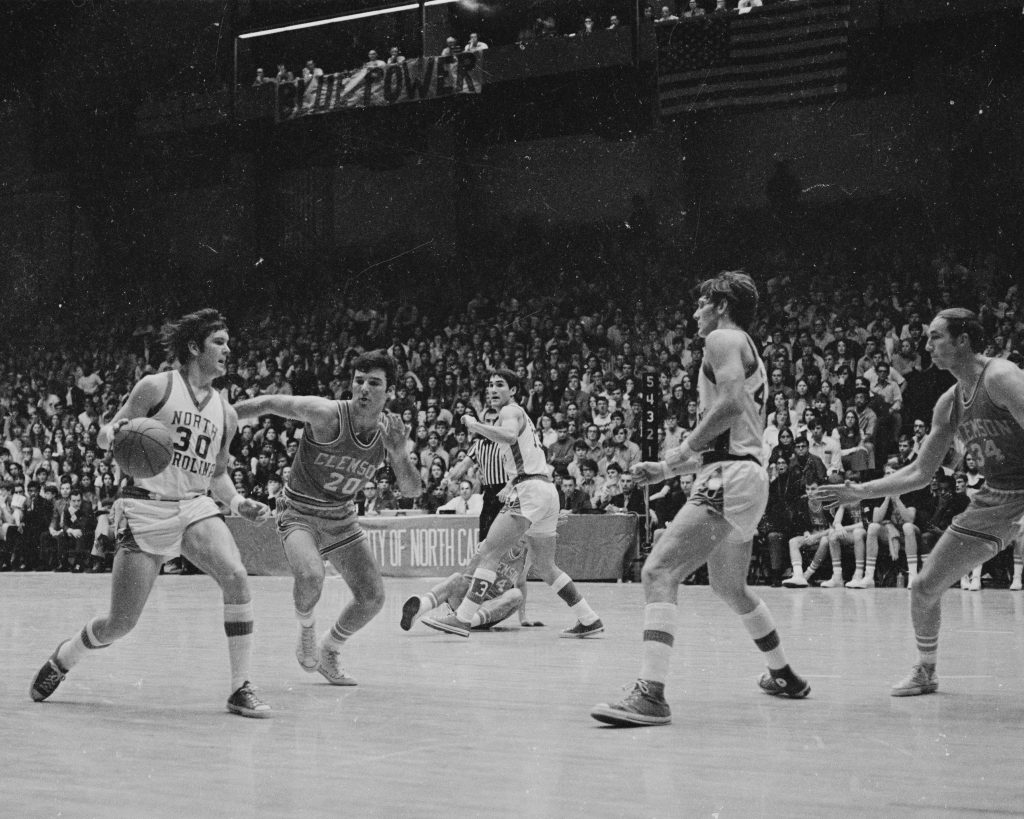
When the two met in Chapel Hill for the twenty-second time on January 10th, 1973, Tar Heel broadcaster Woody Durham, “The Voice of the Tar Heels,” was in place for his first Carolina vs. Clemson-Tar Heel home game, a 92-58 Carolina win. Woody would do play-by-play for the next 33 Carolina – Clemson games in Chapel Hill.
The games in 1974 and 1975 were one and two point wins respectfully for the Heels. A fifteen-point-win in 1976 and a thirty-four-point-win in 1978 preceded another close one in 1980, 73-70.
The game on February 21st, 1981, saw the Heels win by fourteen, 75-61.
Carolina’s 1982 National Championship team beat Clemson 77-72 on January 27th, 1982 on their way to the national title. Tar Heel legend Michael Jordan played his first of two games against Clemson in Chapel Hill, scoring 14 points.
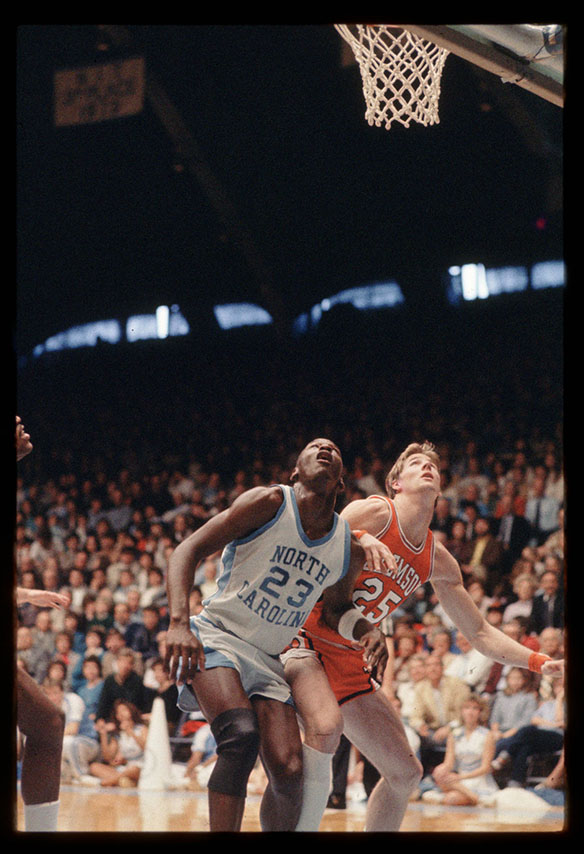
The wins in 1983 and ’85 closed out the era in Carmichael, and Hugh Morton was there for that last meeting on February 23rd, 1985—a thirty-four-point-victory, 84-50.
The Carolina vs. Clemson game on February 1st, 1986 was the first Chapel Hill meeting between the two in the Dean E. Smith Student Activity Center (often called the “Dean Dome”). Hugh Morton was there for this UNC-Clemson game as well as the next four meeting between the two, which included a thirty-six-point win in 1988 and Carolina’s first 100-point effort in the series on February 25th, 1989, 100-86.
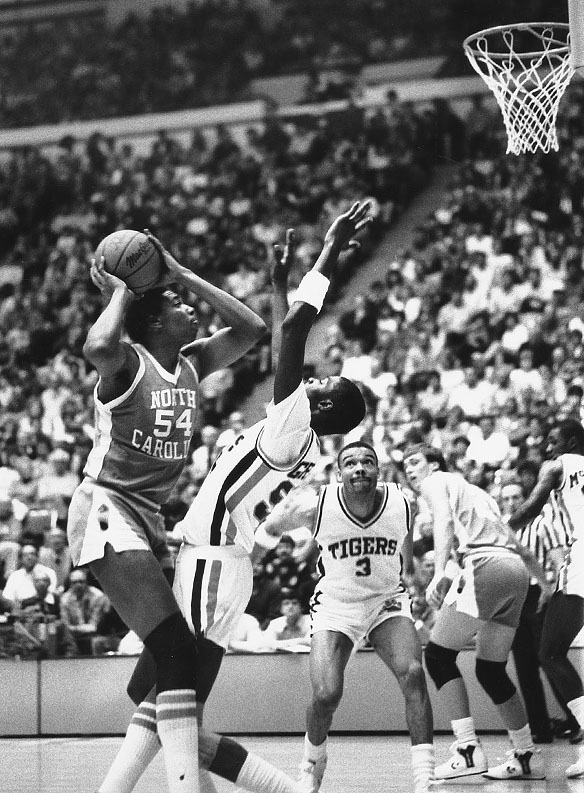
Two double-digit wins, in 1990 and 1991, were followed by another 100+ effort on January 9th, 1992, 103-69.
Carolina’s 1992-93 National Championship run contained a thirteen-point-win, 80-67 on February 17th, 1993 before 21,147 in the Smith Center. The ‘93 NCAA Championship would be coach Dean Smith’s second national title.
The game number forty meeting in January, 1994, was a 44-point-winner, 106-62…Carolina’s largest victory margin of the Chapel Hill series.
Coach Smith closed out his career with double-digit-wins in ’95, ’96, and ’97 with Hugh Morton shooting from courtside at each game. Smith’s January 26th, 1997 win over Clemson was listed by UNC basketball author and historian Adam Lucas as the eighth top game in Smith Center history.
Bill Guthridge, Dean Smith’s assistant from 1967 until 1997, took over the head coaching duties beginning with the 1997–98 season. Coach Guthridge managed three wins over Clemson in Chapel Hill: 1998, 1999, and 2000.
When Clemson arrived in Chapel Hill on January 17th, 2001 for game number forty-seven in the series, new Tar Heel head coach Matt Doherty was in place and led the Heels to a twenty-seven-point-win, 92-65. Coach Doherty would add two more Chapel Hill wins over Clemson in 2002 and 2003.
Current UNC Head Coach Roy Williams was on board for the fiftieth Carolina – Clemson-Chapel Hill meeting on March 2nd, 2004 and continued the winning ways with a 69-53 victory.
When the fifty-first meeting took place on February 19th, 2005, Carolina was on the way to another NCAA Championship. That ’05 win was a thirty-two-point-blowout, 88-56. Coach Williams continued the winning streak with a 76-61 win on February 4th, 2006.
Although game number fifty-three on February 10th, 2008 was a ten-point winner, it was much closer than the final score might indicate. At the end of regulation, the score was tied at 82. After overtime number one it was 90-90. And finally the Tar Heels were able to pull out the 103-93 win in the second overtime. All-American Tyler Hansbrough led the way with 39 points and 13 rebounds.
The twenty-four-point-win on January 21st, 2009 was once again a stepping stone to a national title. Recent games fifty-five through fifty-eight have been double-digit wins for Coach Williams and his Tar Heels. And that brings us to tonight’s fifty-ninth meeting between Clemson and Carolina in Chapel Hill. Whoever wins game 59 . . . the streaks will continue or new ones will begin.
Corrections and clarifications
With the 87-79 UNC victory against Clemson on 21 January 2018, the streak did continue. After the game we reviewed this post in light of the 1952 game-day program having been added to illustrate the article, and we discovered a few mistakes. On February 5th, we made the following changes:
- The phrase “UNC’s 47-30 win on February 19th” omitted the year, which was 1940.
- Sources consulted had not listed the December 8, 1956 game as having been played in Charlotte, so we rewrote the sentence, “A thirty-three-point-win in 1954 and a fifteen-point-win in ’55, set up two Tar Heel wins heading into that famous 1956-57 NCAA Championship season when McGuire let the Heels to two more Chapel Hill wins over Clemson, 94-75 on December 8th, 1956 and 86-54 on January 11th, 1957.” The sentence now only mentions the game played in Chapel Hill on January 11, 1957.
- Clarified the phrase “Carolina’s first 100 point effort on February 25th, 1989, 100-86” to reflect it was the first “in the series,” not the first ever.
- Corrected the game day for 2008 played on February 10th, not January 10th.
- Corrected the game day for 2009 played on January 21st, not January 9th.
- Corrected some typographical errors.
